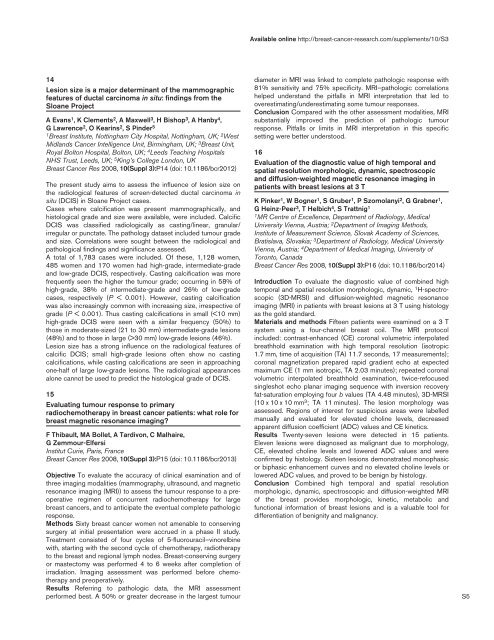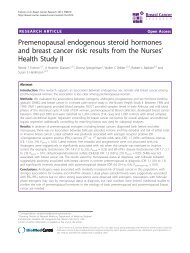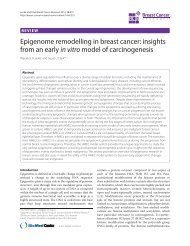Ultrasound-guided axillary node core biopsy - Breast Cancer ...
Ultrasound-guided axillary node core biopsy - Breast Cancer ...
Ultrasound-guided axillary node core biopsy - Breast Cancer ...
Create successful ePaper yourself
Turn your PDF publications into a flip-book with our unique Google optimized e-Paper software.
Available online http://breast-cancer-research.com/supplements/10/S3<br />
14<br />
Lesion size is a major determinant of the mammographic<br />
features of ductal carcinoma in situ: findings from the<br />
Sloane Project<br />
A Evans 1 , K Clements 2 , A Maxwell 3 , H Bishop 3 , A Hanby 4 ,<br />
G Lawrence 2 , O Kearins 2 , S Pinder 5<br />
1 <strong>Breast</strong> Institute, Nottingham City Hospital, Nottingham, UK; 2 West<br />
Midlands <strong>Cancer</strong> Intelligence Unit, Birmingham, UK; 3 <strong>Breast</strong> Unit,<br />
Royal Bolton Hospital, Bolton, UK; 4 Leeds Teaching Hospitals<br />
NHS Trust, Leeds, UK; 5 King’s College London, UK<br />
<strong>Breast</strong> <strong>Cancer</strong> Res 2008, 10(Suppl 3):P14 (doi: 10.1186/bcr2012)<br />
The present study aims to assess the influence of lesion size on<br />
the radiological features of screen-detected ductal carcinoma in<br />
situ (DCIS) in Sloane Project cases.<br />
Cases where calcification was present mammographically, and<br />
histological grade and size were available, were included. Calcific<br />
DCIS was classified radiologically as casting/linear, granular/<br />
irregular or punctate. The pathology dataset included tumour grade<br />
and size. Correlations were sought between the radiological and<br />
pathological findings and significance assessed.<br />
A total of 1,783 cases were included. Of these, 1,128 women,<br />
485 women and 170 women had high-grade, intermediate-grade<br />
and low-grade DCIS, respectively. Casting calcification was more<br />
frequently seen the higher the tumour grade; occurring in 58% of<br />
high-grade, 38% of intermediate-grade and 26% of low-grade<br />
cases, respectively (P < 0.001). However, casting calcification<br />
was also increasingly common with increasing size, irrespective of<br />
grade (P < 0.001). Thus casting calcifications in small (30 mm) low-grade lesions (46%).<br />
Lesion size has a strong influence on the radiological features of<br />
calcific DCIS; small high-grade lesions often show no casting<br />
calcifications, while casting calcifications are seen in approaching<br />
one-half of large low-grade lesions. The radiological appearances<br />
alone cannot be used to predict the histological grade of DCIS.<br />
15<br />
Evaluating tumour response to primary<br />
radiochemotherapy in breast cancer patients: what role for<br />
breast magnetic resonance imaging?<br />
F Thibault, MA Bollet, A Tardivon, C Malhaire,<br />
G Zemmour-Elfersi<br />
Institut Curie, Paris, France<br />
<strong>Breast</strong> <strong>Cancer</strong> Res 2008, 10(Suppl 3):P15 (doi: 10.1186/bcr2013)<br />
Objective To evaluate the accuracy of clinical examination and of<br />
three imaging modalities (mammography, ultrasound, and magnetic<br />
resonance imaging (MRI)) to assess the tumour response to a preoperative<br />
regimen of concurrent radiochemotherapy for large<br />
breast cancers, and to anticipate the eventual complete pathologic<br />
response.<br />
Methods Sixty breast cancer women not amenable to conserving<br />
surgery at initial presentation were accrued in a phase II study.<br />
Treatment consisted of four cycles of 5-fluorouracil–vinorelbine<br />
with, starting with the second cycle of chemotherapy, radiotherapy<br />
to the breast and regional lymph <strong>node</strong>s. <strong>Breast</strong>-conserving surgery<br />
or mastectomy was performed 4 to 6 weeks after completion of<br />
irradiation. Imaging assessment was performed before chemotherapy<br />
and preoperatively.<br />
Results Referring to pathologic data, the MRI assessment<br />
performed best. A 50% or greater decrease in the largest tumour<br />
diameter in MRI was linked to complete pathologic response with<br />
81% sensitivity and 75% specificity. MRI–pathologic correlations<br />
helped understand the pitfalls in MRI interpretation that led to<br />
overestimating/underestimating some tumour responses.<br />
Conclusion Compared with the other assessment modalities, MRI<br />
substantially improved the prediction of pathologic tumour<br />
response. Pitfalls or limits in MRI interpretation in this specific<br />
setting were better understood.<br />
16<br />
Evaluation of the diagnostic value of high temporal and<br />
spatial resolution morphologic, dynamic, spectroscopic<br />
and diffusion-weighted magnetic resonance imaging in<br />
patients with breast lesions at 3 T<br />
K Pinker 1 , W Bogner 1 , S Gruber 1 , P Szomolanyi 2 , G Grabner 1 ,<br />
G Heinz-Peer 3 , T Helbich 4 , S Trattnig 1<br />
1 MR Centre of Excellence, Department of Radiology, Medical<br />
University Vienna, Austria; 2 Department of Imaging Methods,<br />
Institute of Measurement Science, Slovak Academy of Sciences,<br />
Bratislava, Slovakia; 3 Department of Radiology, Medical University<br />
Vienna, Austria; 4 Department of Medical Imaging, University of<br />
Toronto, Canada<br />
<strong>Breast</strong> <strong>Cancer</strong> Res 2008, 10(Suppl 3):P16 (doi: 10.1186/bcr2014)<br />
Introduction To evaluate the diagnostic value of combined high<br />
temporal and spatial resolution morphologic, dynamic, 1 H-spectroscopic<br />
(3D-MRSI) and diffusion-weighted magnetic resonance<br />
imaging (MRI) in patients with breast lesions at 3 T using histology<br />
as the gold standard.<br />
Materials and methods Fifteen patients were examined on a 3 T<br />
system using a four-channel breast coil. The MRI protocol<br />
included: contrast-enhanced (CE) coronal volumetric interpolated<br />
breathhold examination with high temporal resolution (isotropic<br />
1.7 mm, time of acquisition (TA) 11.7 seconds, 17 measurements);<br />
coronal magnetization prepared rapid gradient echo at expected<br />
maximum CE (1 mm isotropic, TA 2.03 minutes); repeated coronal<br />
volumetric interpolated breathhold examination, twice-refocused<br />
singleshot echo planar imaging sequence with inversion recovery<br />
fat-saturation employing four b values (TA 4.48 minutes), 3D-MRSI<br />
(10x10x10mm 3 ; TA 11 minutes). The lesion morphology was<br />
assessed. Regions of interest for suspicious areas were labelled<br />
manually and evaluated for elevated choline levels, decreased<br />
apparent diffusion coefficient (ADC) values and CE kinetics.<br />
Results Twenty-seven lesions were detected in 15 patients.<br />
Eleven lesions were diagnosed as malignant due to morphology,<br />
CE, elevated choline levels and lowered ADC values and were<br />
confirmed by histology. Sixteen lesions demonstrated monophasic<br />
or biphasic enhancement curves and no elevated choline levels or<br />
lowered ADC values, and proved to be benign by histology.<br />
Conclusion Combined high temporal and spatial resolution<br />
morphologic, dynamic, spectroscopic and diffusion-weighted MRI<br />
of the breast provides morphologic, kinetic, metabolic and<br />
functional information of breast lesions and is a valuable tool for<br />
differentiation of benignity and malignancy.<br />
S5






